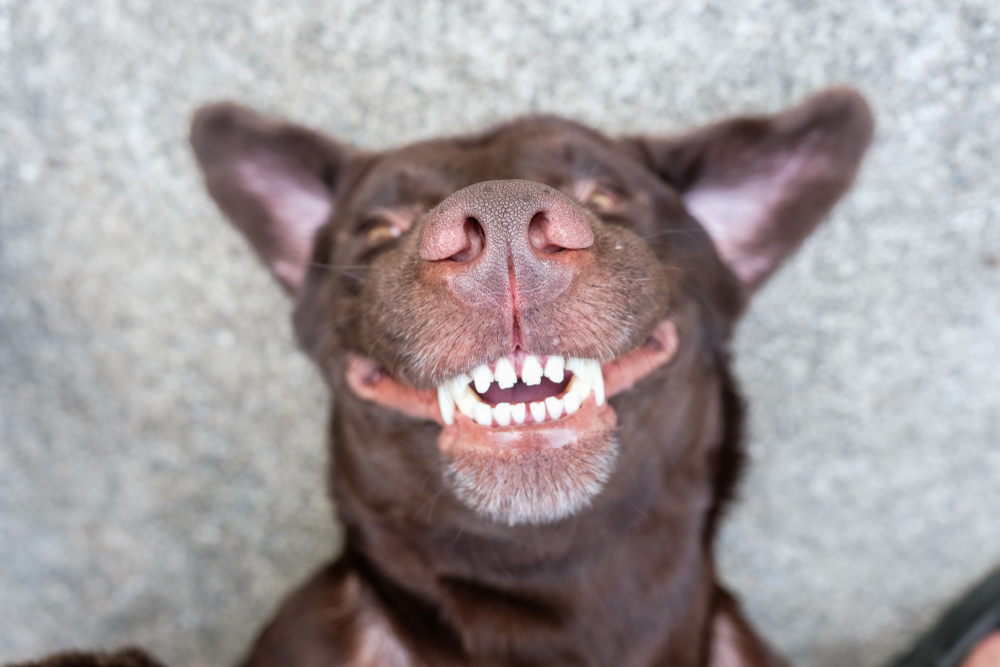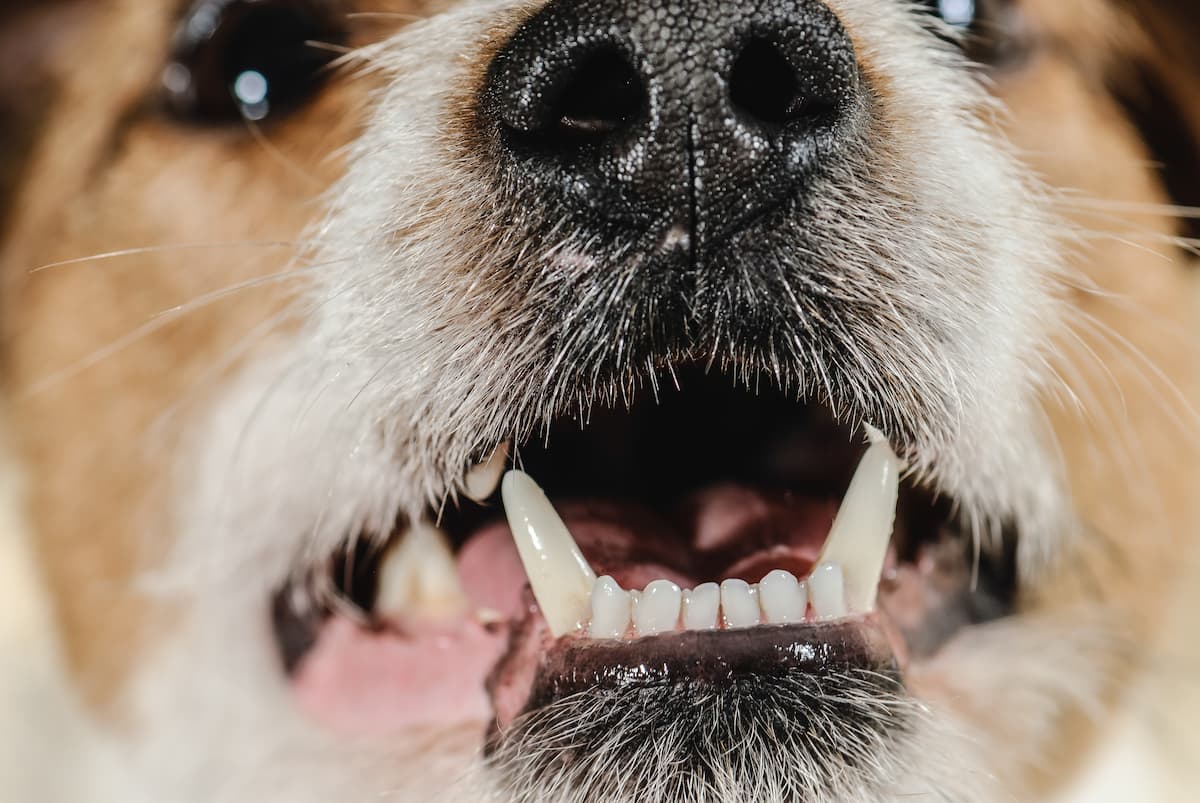Ever peered inside your pooch’s mouth and wondered, “How many teeth do dogs have?” (Nope? Just us?) Luckily for you, finding out the answer doesn’t require you to count your doggo’s chompers one by one. If you’ve ever been curious about exactly how many teeth are sitting inside your dog’s mouth, we’ve got the answers to exactly that and more.
 How many teeth do dogs have?
How many teeth do dogs have?
The answer to “How many teeth do dogs have?” all depends on the dog’s age. When they’re young, dogs have puppy teeth, which are a little different from their adult teeth. Let’s dive a little deeper into each stage.
How many teeth do dogs have when they’re puppies?
When puppies are first born, their teeth aren’t visible. It’s not until around 2-3 weeks of age that tiny little teeth start to surface. Between the ages of 3-12 weeks, a puppy will grow 28 teeth. These consist of 12 incisor teeth, four canines, and 12 premolars.
Puppy teeth are commonly known as “milk teeth” or “needle teeth”, but they’re also referred to as “deciduous teeth”. This is because they’re only temporary. Yep, they eventually make way for other teeth during a puppy’s teething phase – also known as one of the least fun parts of puppy-rearing.
And anyone who’s had a puppy will likely tell you that these teeth may be small, but they’re very mighty. So definitely don’t let a sweet name like “milk teeth” fool you!
What about when they’re adults?
Puppies start losing their teeth around 3-4 months old. When they hit the seven-month mark, they’ll usually have all of their permanent adult teeth in place. Interestingly, they actually gain 14 teeth during the teething phase, bringing the total number of teeth to 42. And that number is consistent regardless of size and breed.
On top of their incisor teeth and canines, adult dogs gain a few more premolars as well as a set of molars. When they’re adults, they have 12 incisors, four canines, 16 premolars, and 10 molars. There’s an equal number of incisors, canines, and premolars on the top and bottom of a dog’s jaw. However, there are four molars in their upper teeth and six in their lower teeth.
 Do dogs have the same number and types of teeth as humans?
Do dogs have the same number and types of teeth as humans?
Nope! Baby humans start out with 20 teeth before ending up with 32 teeth as adults (including wisdom teeth – if they’re removed, we have 28). On average, that’s 10 fewer than our canine comrades. However, we actually have the same types of teeth as our puppers: incisors, canines, premolars, and molars. And much like dogs, we have two sets of teeth over our lifetime.
Aside from the number we have, the main differences between human teeth and dog teeth are their appearance and function. Across their entire set of pearly whites, dogs tend to have sharper, spikier teeth. This is because they descend from wolves, so their teeth are designed to shred and chew on tough meat. Humans, on the other hand, have teeth that work with a more varied diet.
There are also differences between individual types of teeth.
- Incisors. We use our incisors to take bites from our food, while dogs use them to tear meat off a bone. They also use their incisors to groom themselves. (Although, absolutely no judgement if you use your incisors to do the same!)
- Canines. Our canines are a lot less pronounced than our dogs’. In all dogs, the canines are the longest teeth, and are often referred to as “fangs”. We use canines to tear up our food, but dogs use them to hold on to and puncture things
- Premolars. Human premolars are designed to chew on food. Dog premolars are used to shear things, and are decidedly more pointy and craggy than ours. There’s a particularly large premolar known as the carnassial tooth, which takes up a lot of real estate in your dog’s upper jaw. You’ll notice it immediately if you lift your dog’s lip. The carnassial is particularly good at shearing and tearing things up
- Molars. Human and dog molars are probably the most alike, in that both species use them to grind their food. But you’ll notice that dog molars are a lot more jagged
Can adult dogs lose teeth?
Sadly, they can. If this happens, it’s likely due to some kind of dental problem or trauma to the mouth. Here are some of the most common reasons why adult dogs lose their teeth:
- Periodontal disease. This is the biggest cause of tooth loss in adult dogs. In fact, the American Veterinary Association actually estimates that 85 percent of adult pooches have some form of pet dental disease.
- Injury. If a doggo gets into a fight or accident, or chews something that’s a little too hard for their teeth, they could crack or even lose a tooth. A great reason to ensure you buy your furbaby the right chew toy for dogs!
If a dog loses an adult tooth, it unfortunately won’t grow back. That’s why good dental care is crucial – more on that below.
How to keep your dog’s teeth clean
If you want your pupper to retain all or most of their 42 teeth right through old age, good dental hygiene is key.
It’s also important to get your dog accustomed to an oral care routine when they’re still a puppy, because healthy habits always start early. And even if your pooch is in the care of their favourite local Dog Sitter for a few days, make sure the Sitter is aware of your dog’s routine. This will guarantee they can maintain the good habits you’ve established.
Thankfully, we’ve put together everything you need to know on how to keep your dog’s teeth clean, as well as how often to brush your dog’s teeth. You’re welcome!

2 comments
Fantastic article…Thanks for sharing such an amazing content with us.Good job.Keep it up.
Is it possible that they will develop a cavity in their teeth?